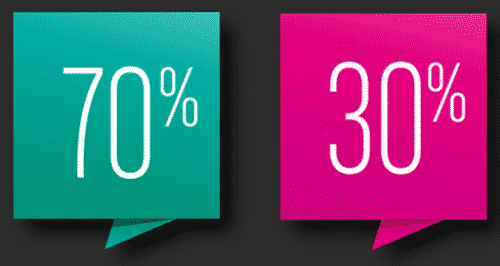Businesses often refer to the 80/20 rule. When they do, it is in this context: 80 percent of our sales come from 20 percent of our customers. Or 20 percent of our customers account for 80 percent of our customer service issues. Almost any organization can probably come up with an 80/20 rule.
In education, we have been struck by a similar pattern and are starting to think that there may be a 70/30 rule in operation.
Here are some proportions for consideration.

Students who perform at the 70th percentile on cognitive ability tests such as the CogAT (the CCAT in Canada) are very likely to learn and perform at “grade level” without adjustments to the curriculum or instruction. That corresponds to 30 percent of the student population.
The percentage of students performing at grade level in the U.S. is about 37 percent in reading at the 4th grade and about 40 percent in math at the fourth grade. The percentages decline and are closer to 30 percent at 8th grade. And that is about the percentage of students one would expect to be performing at grade level, given standard instruction and curriculum and typical performance on cognitive assessments.
Perhaps we should call it the 30/70 rule.
Our work in schools has focused on students in poverty (Title I and other schools with high rates of economic disadvantage). What we typically find is that about 70 percent of students in high-poverty urban schools have significant deficits in attention and/or working memory, compared to about 30 percent in an affluent suburban school. This level of deficit would predict significant academic struggle for these students, requiring substantial adjustments to the curriculum and instruction—another 70/30 ratio.
In any population, there is a top 30 percent and a bottom 70 percent. At MIT, the top 30 percent probably score higher on cognitive tests than the top 30 percent of a national sample. Unlike Lake Woebegone, where all the students are “above average,” – we can’t get every student to the 70th percentile, but what if we could get more students to score at the level that currently represents the 70th percentile? That is, getting them to the level of cognitive capacity that would enable them to learn “without adjustments to the curriculum and instruction?” What if we could get them to “grade level?”
Let’s consider the possibility that a greater percentage of students are not achieving at grade level because of their under-developed cognitive capacity and not because of their effort, or the curriculum and instruction their school provides. And there is substantial evidence that this is the case. In fact, cognitive skills are a greater predictor of the variance in academic performance than almost any other indicator.
To be clear, cognitive capacity is developed. This is not to say that children who have less well-developed cognitive skills can’t learn as well or as fast as others; it merely means that they haven’t YET developed the cognitive capacity to meet the demands of what someone considers to be the standards of grade-level performance.
As one expert observer of education said recently, “If most students are not performing at grade level, then how can that be grade level?”
Without getting into an in-depth discussion of “grade level” expectations — or what might be more relevant, mastery learning — the point is, whatever content and skills we expect students to know (to have mastered) at any point, they need the cognitive capacity to do that. Currently, something like 30 percent of students in the U.S. are performing at that level. And of course, some students are “stretching” and performing at grade level even though they scored below the 70th percentile on a cognitive assessment. The fact that a somewhat higher percentage than 30 percent are achieving at grade level might then be a cause for celebration, but only if there were no opportunity for cognitive growth. If it were possible, say, to increase students’ cognitive capacity, what percentage of students might be able to achieve at grade level?
In studies, increasing students’ cognitive capacity to the 70th percentile resulted in about a grade and a half of growth. And here’s the most important thing; that happened in 12 weeks. 1.5 years of growth is an extremely ambitious target for most students in most schools, for a year, much less in 3 months. But that’s what students need. It’s what they deserve. And it’s what is possible.

What would transforming the 30/70 rule in education to a 70/30 rule be worth? The answer here may surprise you: $72 Trillion in increased productivity in the U.S.? It’s true. And, in part two of this article, we’ll explain.
- edCircuit – Achieving Equity: Knowing the Right Questions to Ask
- Politico – ‘Parents are powerless’: Students face being held back after a year of remote learning
